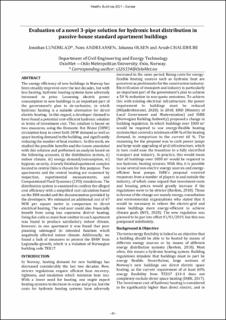| dc.description.abstract | The energy efficiency of new buildings in Norway has been steadily improved over the last decades, but with less heating, hydronic heating systems have adversely increased in price. Lessening electric power consumption in new buildings is an important part of the government’s plan to de-carbonize, in which hydronic heating is a suitable alternative for direct electric heating. In this regard, a developer claimed to have found a potential cost-efficient hydronic solution in terms of investment cost. This solution is based on two measures, using the Domestic Hot Water (DHW) circulation loop to cover both DHW demand as well as space heating demand in the building, and significantly reducing the number of heat emitters. In this work, we studied the possible benefits and the issues associated with this solution and performed an analysis based on the following accounts, i) the distribution system, ii) indoor climate, iii) energy demand/consumption, iv) hygienic security. A newly finished apartment complex located in central Oslo is chosen for this purpose. Two apartments and the central heating are examined by inspection, experimental measurements, and Computational Fluid Dynamics (CFD) simulations. The distribution system is examined to confirm the alleged cost efficiency with a simplified cost calculation based on the BIM-model and the documentation provided by the developers. We estimated an additional cost of 67 NOK per square meter in comparison to direct electrical heating. The end user could also financially benefit from using less expensive district heating. Using fan-coils as main heat emitter in each apartment was found to produce satisfactory indoor climate, however, in one apartment it was found that poor planning sabotaged its intended function which negatively affected indoor climate. Additionally, we found a lack of measures to protect the DHW from Legionella-growth, which is a violation of Norwegian building code TEK17. | |

